Indirect Measurement of Forest Canopy Temperature by Handheld Thermal Infrared Imager through Upward Observation
Abstract
:1. Introduction
2. Materials and Methods
2.1. Thermal Infrared Image
2.2. Thermocouple Temperature
2.3. Methods
2.3.1. Canopy Temperature Measurements
Theory
Emissivity
Sky Ratio
Atmospheric Downward Radiation
2.3.2. Fast Atmospheric Correction Model
Water Vapor Continuum Absorption
Water Vapor Band Type Absorption
Horizontal Path Ozone Absorption
Slant Path Ozone Absorption
Model Verification
Model Calibration
2.3.3. Accuracy Verification
Accuracy Verification of the Fast Atmospheric Correction Model
Accuracy Verification of Canopy Temperature Extracted by Thermal Imager
3. Results
3.1. Accuracy of the Fast Atmospheric Correction Model
3.2. Accuracy of Empirical Model Applied to FLIR T420 Thermal Imager
3.3. Accuracy of the Canopy Temperature Extracted by the Thermal Imager
3.4. Canopy Temperatures
4. Discussion
4.1. Method Accuracy
4.2. Influencing Factors of Thermal Imager Measurement
4.3. Advantages and Limitations of the Proposed Method
5. Conclusions
Author Contributions
Funding
Acknowledgments
Conflicts of Interest
Appendix A
| Latin Name of Tree Species | Latin Name of Tree Species |
|---|---|
| Pinus bungeana Zucc. et Endi | Pterocarya stenoptera C. DC. |
| Juniperus formosana Hayata | Podocarpus macrophyllus (Thunb.) Sweet |
| Robinia pseudoacacia Linn. | Salix babylonica Linn. |
| Syringa reticulata (Blume) H. Hara var. amurensis (Ruprecht)P.S.Green & M.C.Chang | Diospyros kaki Thunb. |
| Salix matsudana Koidz. | Cunninghamia lanceolata (Lamb.) Hook. |
| Platanus occidentalis Linn. | Taxus chinensis (Pilger) Rehd. |
| Fraxinus americana Linn. | Podocarpus nagi (Thunb.) Zoll. et Mor. ex Zoll. |
| Ginkgo biloba Linn. | Michelia wilsonii Finet et Gagnep. |
| Sabina chinensis (Linn.) Ant. | Prunus cerasifera Ehrhart f. atropurpurea (Jacq.) Rehd. |
| Osmanthus fragrans (Thunb.) Lour. | Eucommia ulmoides Oliver |
| Eriobotrya japonica (Thunb.) Lindl. | Pyrus betulifolia Bge. |
| Magnolia denudata Desr. | Metasequoia glyptostroboides Hu et W. C. Cheng |
| Cinnamomum camphora (L.) Presl | Quercus mongolica Fischer ex Ledebour |
| Castanea mollissima Bl. | Syzygium aromaticum(L.)Merr.Et Perry |
| Melia azedarace L. | Lonicera maackii Rupr.Maxim. |
| Pseudolarix amabilis (J. Nelson) Rehder | Fraxinus chinensis Roxb. |
| Photinia serrulata Lindl. | Pinus koraiensis Siebold et Zuccarini |
| Magnolia grandiflora Linn. | Ailanthus altissima (Mill.) Swingle |
References
- Leuzinger, S.; Körner, C. Tree species diversity affects canopy leaf temperatures in a mature temperate forest. Agric. For. Meteorol. 2007, 146, 29–37. [Google Scholar] [CrossRef]
- Hatfield, J. Temperature extremes: Effect on plant growth and development. Weather Clim. Extrem. 2015, 10, 4–10. [Google Scholar] [CrossRef] [Green Version]
- Mangus, D.L.; Sharda, A.; Zhang, N. Development and evaluation of thermal infrared imaging system for high spatial and temporal resolution crop water stress monitoring of corn within a greenhouse. Comput. Electron. Agric. 2016, 121, 149–159. [Google Scholar] [CrossRef]
- Schimper, A. Plant Geography upon a Physiological Basis. Nature 1904, 70, 573–574. [Google Scholar] [CrossRef] [Green Version]
- Grace, J. Temperature as a determinant of plant productivity. Symp. Soc. Exp. Biol. 1988, 42, 91–107. [Google Scholar] [PubMed]
- Gates, D.M. Transpiration and Leaf Temperature. Annu. Rev. Plant Physiol. Plant Mol. Biol. 1968, 19, 211–238. [Google Scholar] [CrossRef]
- Jones, H.G.; Mitchell, C.A. Plants and Microclimate: A Quantitative Approach to Environmental Plant Physiology. Q. Rev. Biol. 1992, 66, 267–268. [Google Scholar] [CrossRef]
- Landsberg, J.J.; Waring, R.H. A generalised model of forest productivity using simplified concepts of radiation-use efficiency, carbon balance and partitioning. For. Ecol. Manag. 1997, 95, 209–228. [Google Scholar] [CrossRef]
- Aber, J.D.; Reich, P.B.; Goulden, M.L. Extrapolating leaf CO2 exchange to the canopy: A generalized model of forest photosynthesis compared with measurements by eddy correlation. Oecologia 1996, 106, 257–265. [Google Scholar] [CrossRef] [Green Version]
- Schimel, D.S.; Braswell, B.H.; Holland, E.A.; McKeown, R.; Ojima, D.S.; Painter, T.H.; Parton, W.J.; Townsend, A.R. Climatic, edaphic, and biotic controls over storage and turnover of carbon in soils. Glob. Biogeochem. Cycle 1994, 8, 279–293. [Google Scholar] [CrossRef] [Green Version]
- Tague, C.L.; Band, L.E. RHESSys: Regional Hydro-Ecologic Simulation System—An Object-Oriented Approach to Spatially Distributed Modeling of Carbon, Water, and Nutrient Cycling. Earth Interact. 2004, 8, 1–42. [Google Scholar] [CrossRef]
- Blad, B.L.; Rosenberg, N.J. Measurement of Crop Temperature by Leaf Thermocouple, Infrared Thermometry and Remotely Sensed Thermal Imagery. Agron. J. 1976, 68, 635–641. [Google Scholar] [CrossRef]
- Pieters, G.A. Measurements of leaf temperature by thermocouples or infrared thermometry in connection with exchange phenomena and temperature distribution. Meded. Landbouwhogesch. Wageninge. 1972, 72-34, 1–20. [Google Scholar]
- Lomas, J.; Schlesinger, E.; Israeli, A. Leaf temperature measurement techniques. Bound. Layer Meteorol. 1971, 1, 458–465. [Google Scholar] [CrossRef]
- Berliner, P.; Oosterhuis, D.M.; Green, G.C. Evaluation of the infrared thermometer as a crop stress detector. Agric. For. Meteorol. 1984, 31, 219–230. [Google Scholar] [CrossRef]
- French, A.; Schmugge, T.; Kustas, W.P. Estimating Evapotranspiration with ASTER Thermal Infrared Imagery. In Proceedings of the IEEE International Geoscience and Remote Sensing Symposium, Sydney, NSW, Australia, 9–13 July 2001. [Google Scholar]
- Guillevic, P.; Bork-Unkelbach, A.; Göttsche, F.-M.; Hulley, G.; Gastellu-Etchegorry, J.-P.; Olesen, F.; Privette, J. Directional viewing effects on satellite Land Surface Temperature products over sparse vegetation canopies—A multi-sensor analysis. IEEE Geosci. Remote Sens. Lett. 2013, 10, 1464–1468. [Google Scholar] [CrossRef]
- Seguin, B.; Dominique, C.; Guerif, M. Surface temperature and evapotranspiration: Application of local scale methods to regional scales using satellite data. Remote Sens. Environ. 1994, 49, 287–295. [Google Scholar] [CrossRef]
- Egea, G.; Padilla-Díaz, C.M.; Martinez-Guanter, J.; Fernández, J.E.; Pérez-Ruiz, M. Assessing a crop water stress index derived from aerial thermal imaging and infrared thermometry in super-high density olive orchards. Water Manag. 2017, 187, 210–221. [Google Scholar] [CrossRef] [Green Version]
- Ludovisi, R.; Tauro, F.; Salvati, R.; Khoury, S.; Mugnozza Scarascia, G.; Harfouche, A. UAV-Based Thermal Imaging for High-Throughput Field Phenotyping of Black Poplar Response to Drought. Front. Plant Sci. 2017, 8, 1681. [Google Scholar] [CrossRef]
- Aubrecht, D.M.; Helliker, B.R.; Goulden, M.L.; Roberts, D.A.; Still, C.J.; Richardson, A.D. Continuous, long-term, high-frequency thermal imaging of vegetation: Uncertainties and recommended best practices. Agric. For. Meteorol. 2016, 228–229, 315–326. [Google Scholar] [CrossRef] [Green Version]
- Ballester, C.; Castel, J.; Jiménez-Bello, M.A.; Castel, J.R.; Intrigliolo, D.S. Thermographic measurement of canopy temperature is a useful tool for predicting water deficit effects on fruit weight in citrus trees. Agric. Water Manag. 2013, 122, 1–6. [Google Scholar] [CrossRef]
- Berger, B.; Parent, B.; Tester, M. High-throughput shoot imaging to study drought responses. J. Exp. Bot. 2010, 61, 3519–3528. [Google Scholar] [CrossRef] [Green Version]
- Chaerle, L.; Van Caeneghem, W.; Messens, E.; Lambers, H.; Van Montagu, M. Presymptomatic visualization of plant-virus interactions by thermography. Nat. Biotechnol. 1999, 17, 813–816. [Google Scholar] [CrossRef]
- Stoll, M.; Schultz, H.R.; Baecker, G.; Berkelmann-Loehnertz, B. Early pathogen detection under different water status and the assessment of spray application in vineyards through the use of thermal imagery. Precis. Agric. 2008, 9, 407–417. [Google Scholar] [CrossRef]
- Cohen, Y.; Alchanatis, V.; Meron, M.; Saranga, Y.; Tsipris, J. Estimation of leaf water potential by thermal imagery and spatial analysis. J. Exp. Bot. 2005, 56, 1843–1852. [Google Scholar] [CrossRef] [Green Version]
- Struthers, R.; Ivanova, A.; Tits, L.; Swennen, R.; Coppin, P. Thermal infrared imaging of the temporal variability in stomatal conductance for fruit trees. Int. J. Appl. Earth Obs. Geoinf. 2015, 39, 9–17. [Google Scholar] [CrossRef]
- Rodriguez, D.; Sadras, V.O.; Christensen, L.K.; Belford, R. Spatial assessment of the physiological status of wheat crops as affected by water and nitrogen supply using infrared thermal imagery. Aust. J. Agric. Res. 2005, 56, 983–993. [Google Scholar] [CrossRef]
- Scherrer, D.; Bader, M.K.-F.; Körner, C. Drought-sensitivity ranking of deciduous tree species based on thermal imaging of forest canopies. Agric. For. Meteorol. 2011, 151, 1632–1640. [Google Scholar] [CrossRef]
- Kim, J.Y.; Glenn, D.M. Multi-modal sensor system for plant water stress assessment. Comput. Electron. Agric. 2017, 141, 27–34. [Google Scholar] [CrossRef]
- Smith, S.; Toumi, R. Measuring Cloud Cover and Brightness Temperature with a Ground-Based Thermal Infrared Camera. J. Appl. Meteorol. Climatol. 2008, 47, 683–693. [Google Scholar] [CrossRef]
- Kneizys, F.; Shettle, E.; Abreu, L.; Chetwynd, J.; Anderson, G. User Guide to LOWTRAN 7; Air Force Geophysics Laboratory: Hanscom AFB, Bedford, MA, USA, 1988. [Google Scholar]
- Berk, A.; Anderson, G.P.; Acharya, P.K. MODTRAN4 User’s Manual; Air Force Geophysics Laboratory: Hanscom AFB, Bedford, MA, USA, 1999. [Google Scholar]
- Chou, M.-D.; Kratz, D.P.; Ridgway, W. Infrared Radiation Parameterizations in Numerical Climate Models. J. Clim. 1991, 4, 424–437. [Google Scholar] [CrossRef] [Green Version]
- French, A.N.; Norman, J.M.; Anderson, M.C. A simple and fast atmospheric correction for spaceborne remote sensing of surface temperature. Remote Sens. Environ. 2003, 87, 326–333. [Google Scholar] [CrossRef]
- Durre, I.; Vose, R.S.; Wuertz, D.B. Overview of the Integrated Global Radiosonde Archive. J. Clim. 2006, 19, 53–68. [Google Scholar] [CrossRef] [Green Version]
- Hersbach, H.; Bell, B.; Berrisford, P.; Hirahara, S.; Horányi, A.; Muñoz Sabater, J.; Nicolas, J.; Peubey, C.; Radu, R.; Schepers, D.; et al. The ERA5 global reanalysis. Q. J. R. Meteorol. Soc. 2020, 146, 1999–2049. [Google Scholar] [CrossRef]
- Chen, C. Determining the leaf emissivity of three crops by infrared thermometry. Sensors 2015, 15, 11387–11401. [Google Scholar] [CrossRef] [Green Version]
- Ribeiro da Luz, B.; Crowley, J.K. Spectral reflectance and emissivity features of broad leaf plants: Prospects for remote sensing in the thermal infrared (8.0–14.0 μm). Remote Sens. Environ. 2007, 109, 393–405. [Google Scholar] [CrossRef]
- Ullah, S.; Schlerf, M.; Skidmore, A.K.; Hecker, C. Identifying plant species using mid-wave infrared (2.5–6 μm) and thermal infrared (8–14 μm) emissivity spectra. Remote Sens. Environ. 2012, 118, 95–102. [Google Scholar] [CrossRef]
- Galve, J.M.; Coll, C.; Sánchez, J.M.; Valor, E.; Niclòs, R.; Pérez-Planells, L.; Doña, C.; Caselles, V. Single band atmospheric correction tool for thermal infrared data: Application to Landsat 7 ETM+. In Proceedings of the SPIE Remote Sensing, New Delhi, India, 4–7 April 2016. [Google Scholar]
- Barsi, J.; Schott, J.; Palluconi, F.; Hook, S. Validation of a web-based atmospheric correction tool for single thermal band instruments. In Proceedings of the SPIE: Optics and Photonic, San Diego, CA, USA, 31 July–4 August 2005; Volume 5882. [Google Scholar]
- Jiménez-Muñoz, J.C.; Sobrino, J.A.; Mattar, C.; Franch, B. Atmospheric correction of optical imagery from MODIS and Reanalysis atmospheric products. Remote Sens. Environ. 2010, 114, 2195–2210. [Google Scholar] [CrossRef]
- Costa, J.M.; Grant, O.M.; Chaves, M.M. Thermography to explore plant-environment interactions. J. Exp. Bot. 2013, 64, 3937–3949. [Google Scholar] [CrossRef]
- Weiss, M.; Baret, F. CAN-EYE V6.1 User Manual; National Institute of Agricultural Research: Paris, French, 2010. [Google Scholar]
- Ellicott, E.; Vermote, E.; Petitcolin, F.; Hook, S.J. Validation of a New Parametric Model for Atmospheric Correction of Thermal Infrared Data. IEEE Trans. Geosci. Remote Sens. 2009, 47, 295–311. [Google Scholar] [CrossRef]
- Jiang, G.M. Intercalibration of infrared channels of polar-orbiting IRAS/FY-3A with AIRS/Aqua data. Opt. Express 2010, 18, 3358–3363. [Google Scholar] [CrossRef]
- Roberts, R.E.; Selby, J.E.A.; Biberman, L.M. Infrared continuum absorption by atmospheric water vapor in the 8–12-μm window. Appl. Opt. 1976, 15, 2085–2090. [Google Scholar] [CrossRef] [PubMed]
- Price, J.C. Estimating surface temperatures from satellite thermal infrared data—A simple formulation for the atmospheric effect. Remote Sens. Environ. 1983, 13, 353–361. [Google Scholar] [CrossRef]
- Rothman, L.S.; Gordon, I.E.; Barbe, A.; Benner, D.C.; Bernath, P.F.; Birk, M.; Boudon, V.; Brown, L.R.; Campargue, A.; Champion, J.P.; et al. The HITRAN 2008 molecular spectroscopic database. J. Quant. Spectrosc. Radiat. Transf. 2009, 110, 533–572. [Google Scholar] [CrossRef] [Green Version]
- Borbas, E.E.; Seemann, S.W.; Huang, H.L.; Li, J.; Menzel, W.P. Global profile training database for satellite regression retrievals with estimates of skin temperature and emissivity. In Proceedings of the XIV International ATOVS Study Conference, Beijing, China, 25–31 May 2005; pp. 763–770. [Google Scholar]
- Kratz, D.P. The correlated k-distribution technique as applied to the AVHRR channels. J. Quant. Spectrosc. Radiat. Transf. 1995, 53, 501–517. [Google Scholar] [CrossRef]
- Göttsche, F.-M.; Olesen, F.S. Evolution of neural networks for radiative transfer calculations in the terrestrial infrared. Remote Sens. Environ. 2002, 80, 157–164. [Google Scholar] [CrossRef]
- Grant, O.M.; Chaves, M.M.; Jones, H.G. Optimizing thermal imaging as a technique for detecting stomatal closure induced by drought stress under greenhouse conditions. Physiol. Plant. 2006, 127, 507–518. [Google Scholar] [CrossRef]
- Guoquan, D.; Zhengzhi, L.I. The apparent emissivity of vegetation canopies. Int. J. Remote Sens. 1993, 14, 183–188. [Google Scholar] [CrossRef]
- Niemela, S.; Raisanen, P.; Savijarvi, H. Comparison of surface radiative flux parameterizations: Part I: Longwave radiation. Atmos. Res. 2001, 58, 1–18. [Google Scholar] [CrossRef]
- Smith, W.K.; Carter, G.A. Shoot Structural Effects on Needle Temperatures and Photosynthesis in Conifers. Am. J. Bot. 1988, 75, 496–500. [Google Scholar] [CrossRef]
- Doughty, C.E.; Goulden, M.L. Are tropical forests near a high temperature threshold? J. Geophys. Res. Biogeosci. 2008, 113, G00B07. [Google Scholar] [CrossRef] [Green Version]
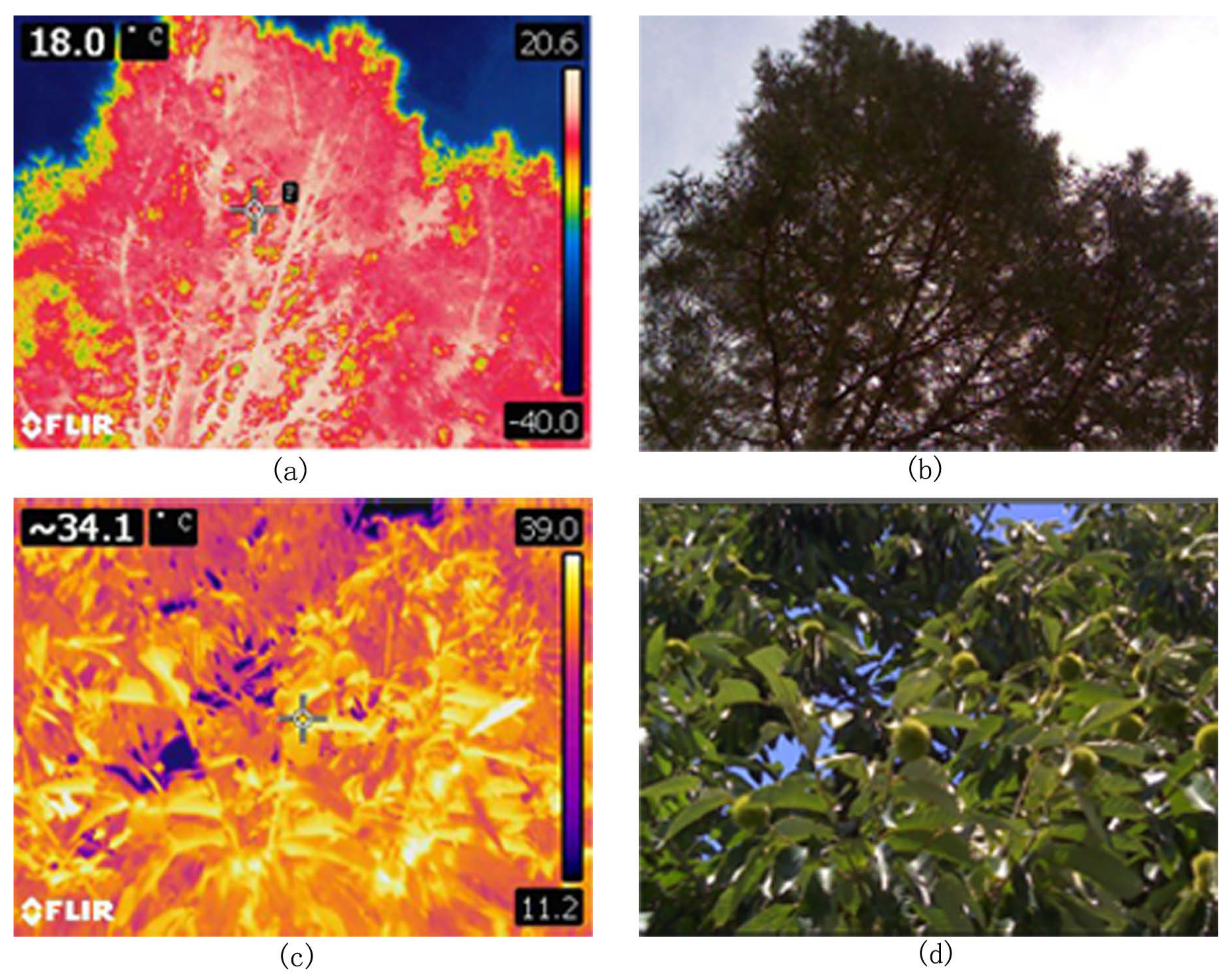
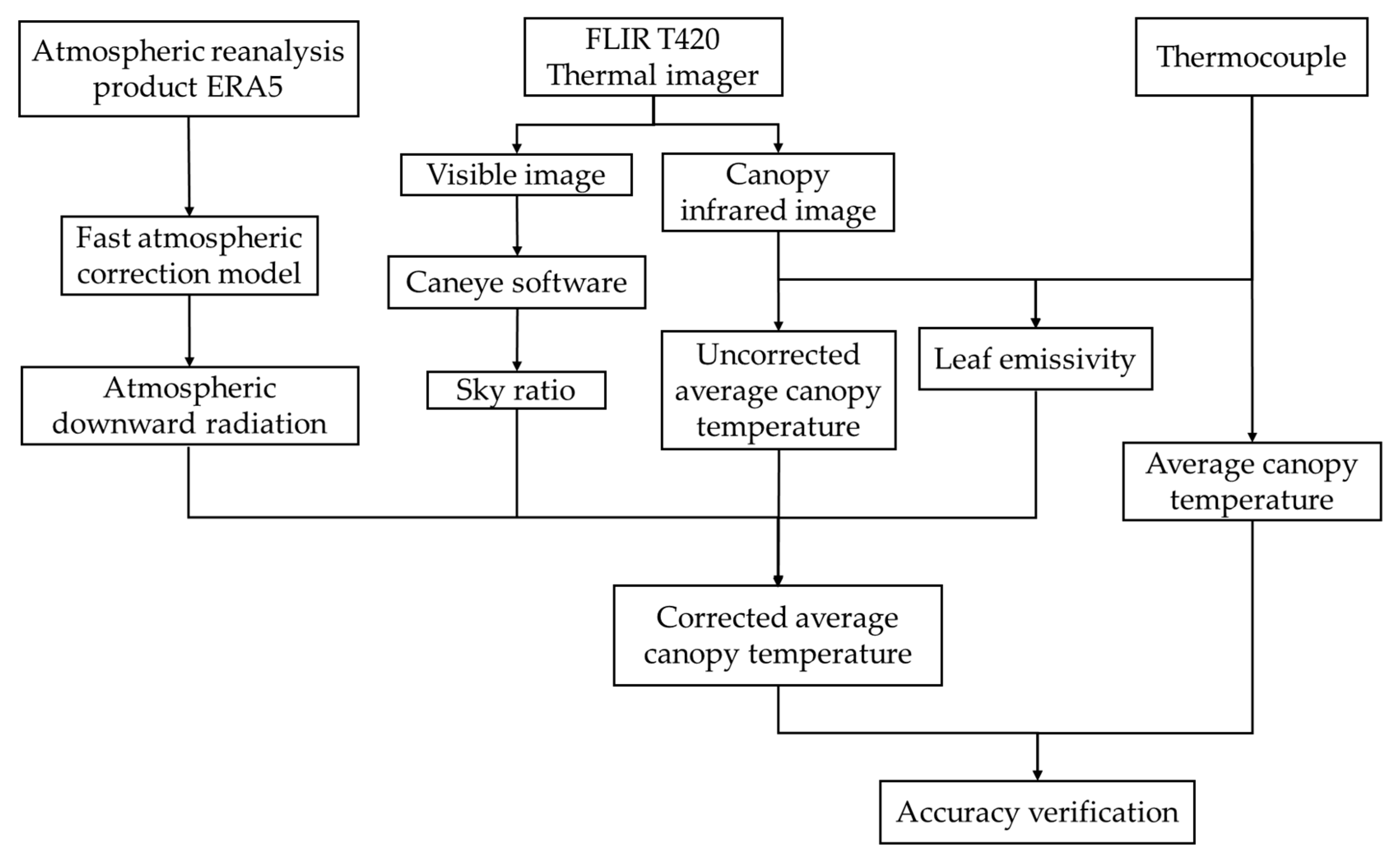
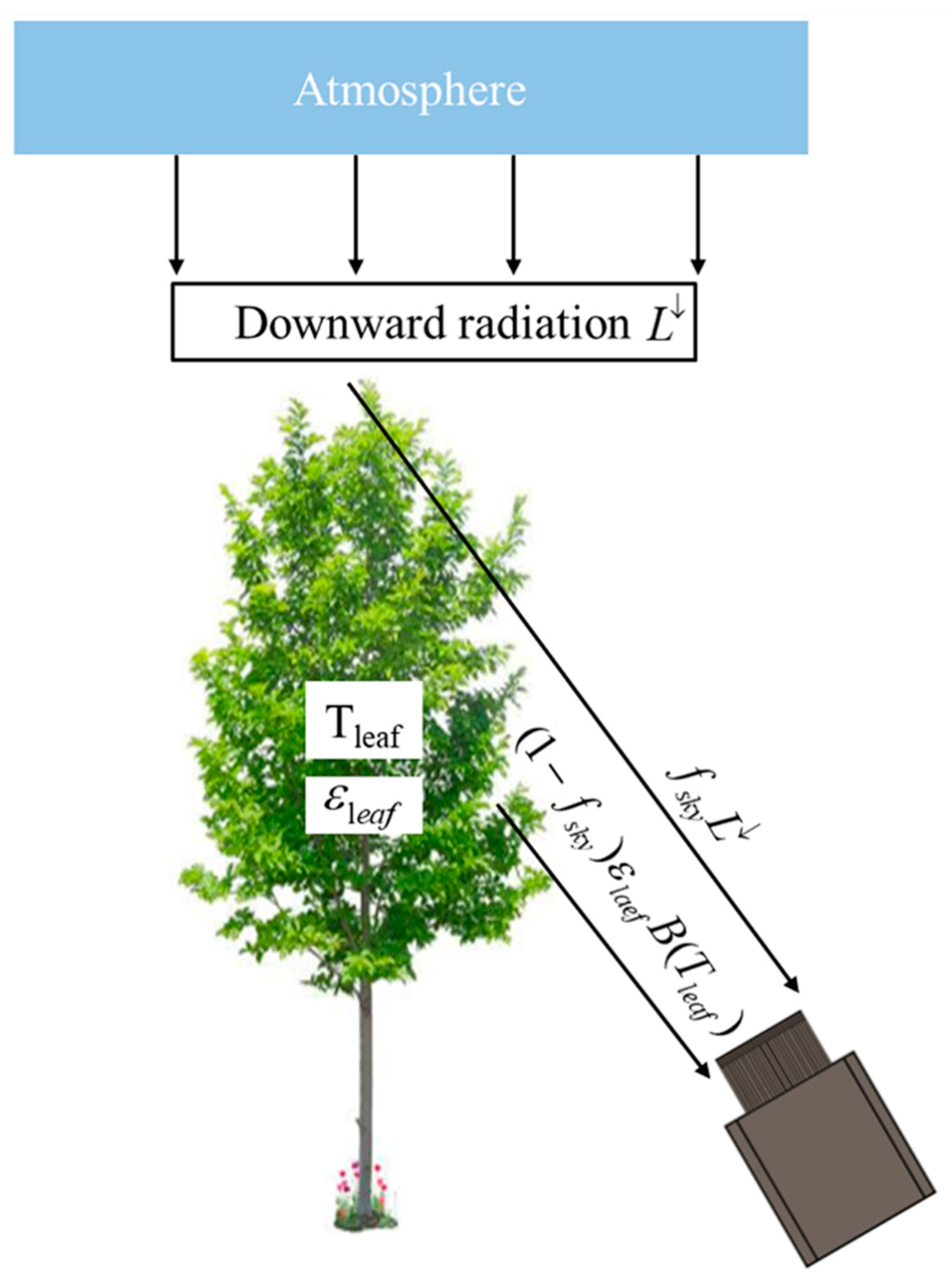

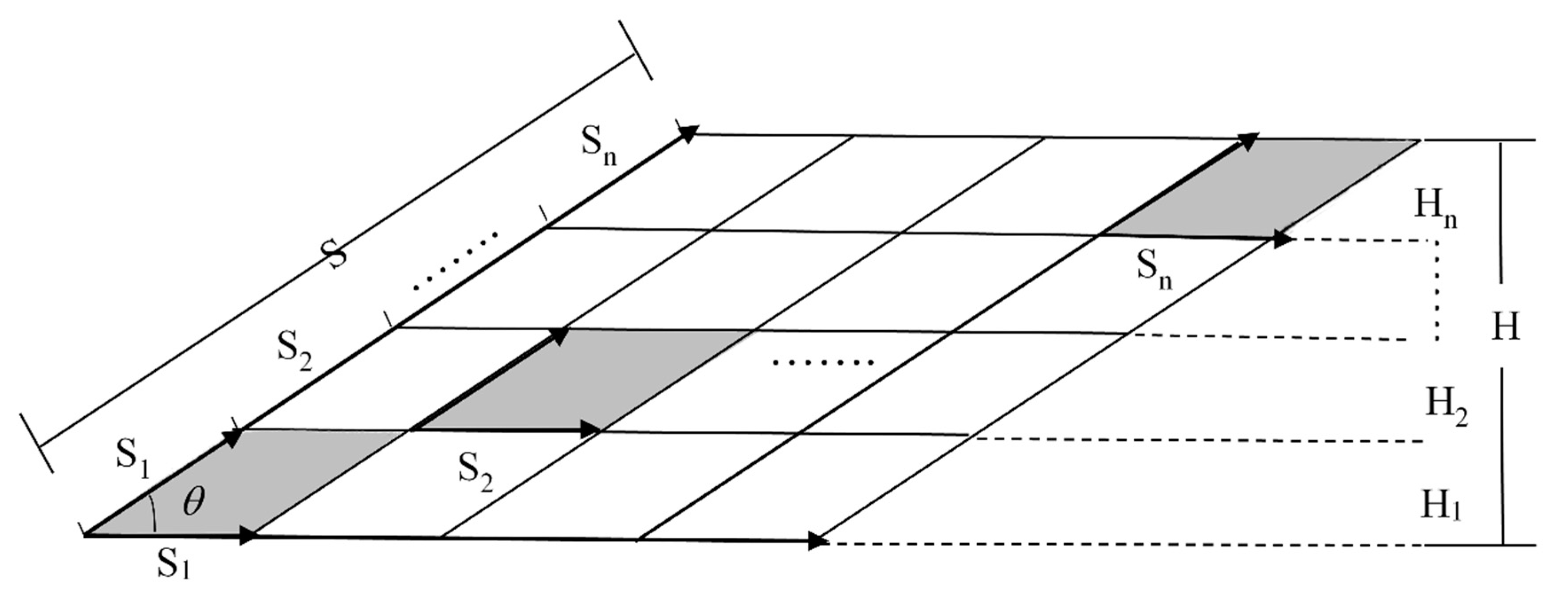



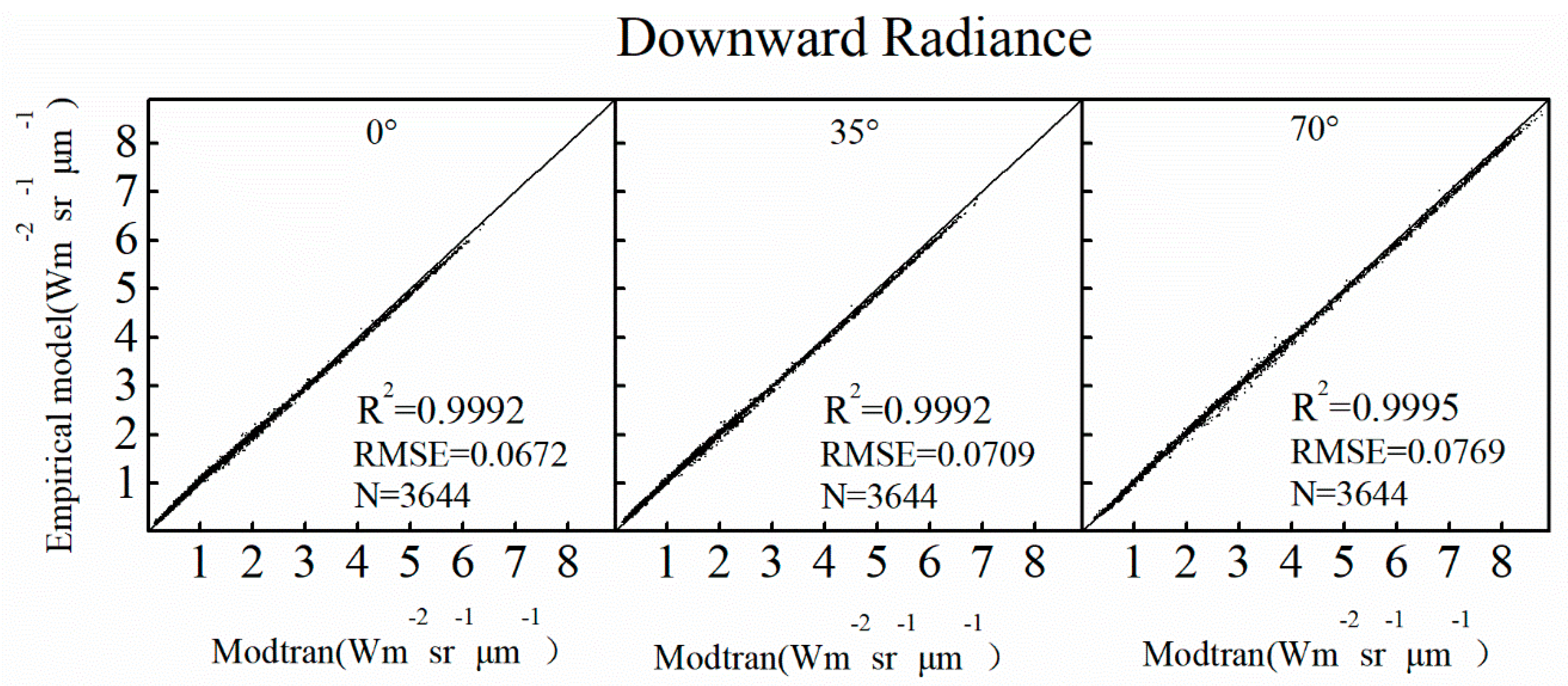
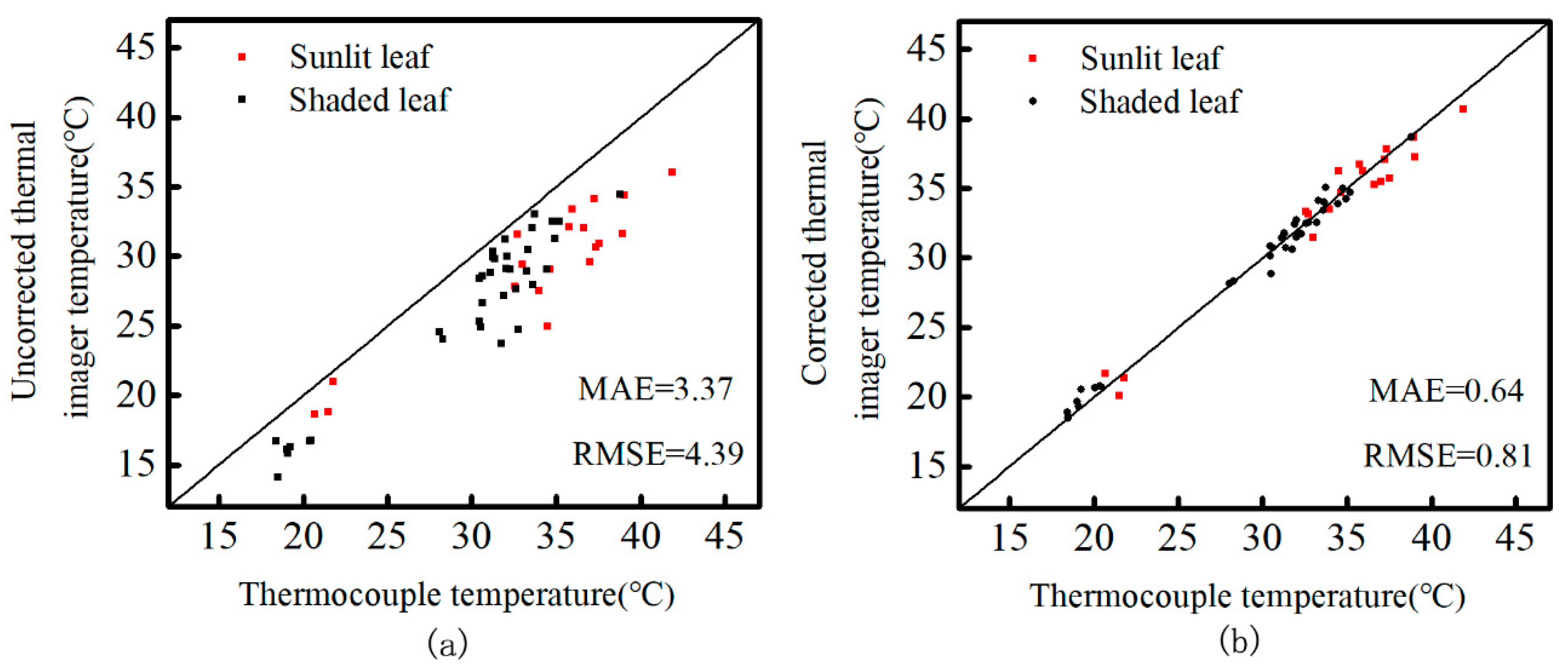

| Height (km) | Pressure (kPa) | Ozone Column Density | |||||||
|---|---|---|---|---|---|---|---|---|---|
| h = 10 | h = 30 | h = 50 | h = 70 | h = 90 | h = 110 | h = 130 | |||
| 0 | 101.3 | 0.0028 | 9.82 | 28.27 | 45.29 | 61.01 | 75.52 | 88.92 | 101.24 |
| 5 | 55.4 | 0.00308 | 9.66 | 27.06 | 42.40 | 56.10 | 68.39 | 79.47 | 89.47 |
| 10 | 28.1 | 0.0042 | 9.19 | 23.89 | 35.58 | 45.32 | 53.65 | 56.54 | 67.36 |
| 15 | 13 | 0.00812 | 7.70 | 16.87 | 23.13 | 28.03 | 32.12 | 35.67 | 38.81 |
| 20 | 5.95 | 0.0146 | 5.71 | 10.88 | 14.29 | 17.00 | 19.28 | 21.29 | 23.07 |
| 25 | 2.77 | 0.0159 | 4.62 | 8.37 | 10.89 | 12.91 | 14.64 | 16.17 | 17.55 |
| 30 | 1.32 | 0.0107 | 4.18 | 7.41 | 9.60 | 11.37 | 12.89 | 14.24 | 15.47 |
| 35 | 0.652 | 0.00638 | 3.97 | 6.78 | 8.68 | 10.22 | 11.54 | 12.73 | 13.81 |
| 40 | 0.333 | 0.00263 | 4.82 | 7.85 | 9.79 | 11.34 | 12.66 | 13.86 | 14.93 |
| 50 | 0.0951 | 0.00026 | 9.72 | 23.07 | 31.01 | 36.49 | 40.57 | 43.92 | 46.71 |
| 60 | 0.0272 | 0.00004 | 8.68 | 25.43 | 40.91 | 55.45 | 68.35 | 79.94 | 90.54 |
| Sunny/Shady | n | Mean Absolute Error (MAE) | Root Mean Square Error (RMSE) |
|---|---|---|---|
| Sunny | 19 | 0.93 | 1.10 |
| Shady | 37 | 0.49 | 0.61 |
Publisher’s Note: MDPI stays neutral with regard to jurisdictional claims in published maps and institutional affiliations. |
© 2020 by the authors. Licensee MDPI, Basel, Switzerland. This article is an open access article distributed under the terms and conditions of the Creative Commons Attribution (CC BY) license (http://creativecommons.org/licenses/by/4.0/).
Share and Cite
Su, A.; Qi, J.; Huang, H. Indirect Measurement of Forest Canopy Temperature by Handheld Thermal Infrared Imager through Upward Observation. Remote Sens. 2020, 12, 3559. https://doi.org/10.3390/rs12213559
Su A, Qi J, Huang H. Indirect Measurement of Forest Canopy Temperature by Handheld Thermal Infrared Imager through Upward Observation. Remote Sensing. 2020; 12(21):3559. https://doi.org/10.3390/rs12213559
Chicago/Turabian StyleSu, Anni, Jianbo Qi, and Huaguo Huang. 2020. "Indirect Measurement of Forest Canopy Temperature by Handheld Thermal Infrared Imager through Upward Observation" Remote Sensing 12, no. 21: 3559. https://doi.org/10.3390/rs12213559








